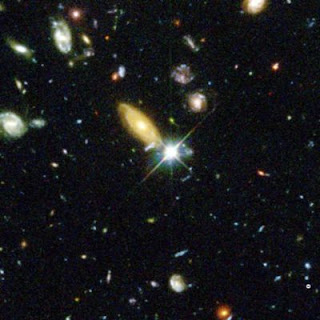My two prior posts related to the search for life outside the Solar system. The Seti program currently involves listening for radio signals from a civilization on another planet, while the Kepler mission is looking for small planets that eclipse (transit) their host star and are in orbits that keep them just warm enough for liquid water to be stable on the surface. Sometimes we might wonder, "Why not just look for planets directly?" We expect to, some day, but I'll come to that. Let's determine what we are up against.
These days, Jupiter is a bright presence in the evening sky, two or three times as bright as Sirius, the visibly brightest star. How bright would it be if it were far away? More to the point, how bright would Earth be if we were observed by someone about ten parsecs away?
If both Jupiter and Earth were observed from outside the Solar system, Jupiter would be about five times as bright as Earth. Although it is five times as far from the Sun, it is 10.7 times the diameter, or 115 times the area. Now move away ten parsecs (32.6 light years). This is the standard distance for defining absolute magnitude. At this distance, the Sun's brightness is 4.8 magnitudes. At this same distance, the Earth's brightness is at most 27.6 magnitudes. If we calculate out what this means, the Sun is about 1.3 billion times as bright as the Earth.
Modern telescopes can see stars of 30th and even 32d (apparent) magnitude. The kicker is, not when they are very close to brighter stars, particularly not stars of fifth magnitude, which is very bright. From ten parsecs away, the maximum separation between the Earth and the Sun is 0.1" (a tenth of an arc second, or 1/36,000 degree). That is very close indeed. Although a telescope such as the Hubble Space Telescope can resolve objects that are within 0.03" of one another, that is only if their brightness is quite similar. Take a look at the following image.
 This is a small portion of the Hubble Deep Field. While the astronomers purposely picked a nearly star-free bit of sky to look through at distant galaxies, they could not avoid a couple of stars. The one near center of this image is about a fifteenth magnitude star. See how light scattering inside the telescope has puffed up its image to a size larger than the image of many of the smaller galaxies nearby? That illustrates the problem.
This is a small portion of the Hubble Deep Field. While the astronomers purposely picked a nearly star-free bit of sky to look through at distant galaxies, they could not avoid a couple of stars. The one near center of this image is about a fifteenth magnitude star. See how light scattering inside the telescope has puffed up its image to a size larger than the image of many of the smaller galaxies nearby? That illustrates the problem.A point only 0.1" from the center of that star's image is well within the washed-out circle, but a planet would not be visible even in the much larger gray-green halo. What can be done to improve the contrast?
A mission NASA is planning, provisionally called the Terrestrial Planet Finder, would use four telescopes attached to a long boom, whose light could be combined to null the star's bright image, while enhancing that of a very nearby planet. The last I read, there isn't a set launch date, just a fuzzy objective a decade or more away. When you are working against a billion-to-one contrast ratio, over angular distances much less than an arc second, this is the kind of approach that is needed.
May the time come that we can look at a planet directly and measure its potential for life, or the level of life present! It makes me wonder just how many years away we are from a time when we will know for sure that some kind of life exists "out there."



No comments:
Post a Comment